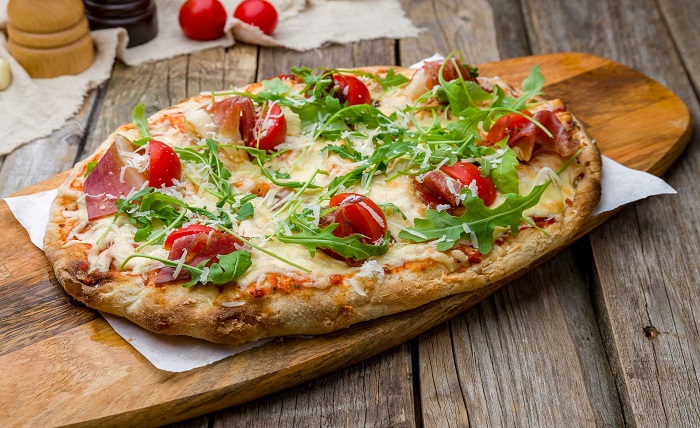Pinsa: A Delicious and Healthy Alternative to Pizza

Pizza is one of the most popular and beloved foods in the world, but it can also be high in calories, fat, and gluten. If you are looking for a delicious and healthy alternative to pizza, you might want to try pinsa, a Roman-style pizza with a light, airy crust, usually made of soy, rice, and wheat flour. In this blog post, we will tell you what pinsa is, how it differs from pizza, how to make it at home, and where to find it.
What is Pinsa?
Pinsa is a type of flatbread that originated in ancient Rome. The word pinsa comes from the Latin “pinsere”, which means to stretch, press down, and extend. This is the technique used to shape pizza and focaccia. In fact, pinsa is a sort of mix between the two.
Pinsa is made of a dough that contains soy, rice, and wheat flour. These flours have less gluten than standard wheat flour, making the dough more digestible and less likely to cause bloating. The dough is also highly hydrated, meaning that it contains a lot of water. This makes the dough light and airy, with a crispy crust and a soft interior.
Pinsa can be topped with various ingredients, such as cheese, sauce, meat, vegetables, and herbs. The toppings are usually simple and fresh, reflecting the Mediterranean cuisine. Some of the most common toppings are tomato sauce, mozzarella cheese, basil leaves, ham, mushrooms, olives, anchovies, and artichokes.
How Does Pinsa Differ from Pizza?
Pinsa and pizza have some similarities, such as being flatbreads with cheese, sauce, and other toppings. However, they also have some differences that make them distinct dishes. Some of the main differences are:
- Shape: Pinsa tends to be stretched into oblong, lengthened ovals. Pizza can have various shapes, but it is usually round or square.
- Dough: Pinsa dough uses soy, rice, and wheat flour, while pizza dough uses 100% standard wheat flour. Pinsa dough also has more water than pizza dough, making it more hydrated.
- Fermentation: Pinsa dough ferments for longer than pizza dough, usually for two days or more. This enhances the flavor and texture of the dough, as well as making it easier to digest.
- Crust: Pinsa crust is light and crisp, with large air bubbles. Pizza crust can vary depending on the style, but it usually has a springy and chewy texture.
Read more about Roger That Foods: A Meat Lover’s Paradise
How to Make Pinsa at Home?
Making pinsa at home is not very difficult, but it requires some time and patience. Here are the basic steps to make pinsa at home:
- Make the dough: In a large bowl, mix 300 grams of soy flour, 200 grams of rice flour, and 500 grams of wheat flour. Add 10 grams of salt and 3 grams of dry yeast. Gradually add 900 milliliters of water and knead the dough until smooth and elastic. Transfer the dough to a lightly greased bowl and cover with plastic wrap. Let it rise in a warm place for about an hour.
- Divide the dough: Punch down the dough and divide it into 8 equal pieces. Shape each piece into a ball and place them on a baking sheet lined with parchment paper. Cover with plastic wrap and let them rest in the refrigerator for 24 hours.
- Shape the pinsa: Take out one ball of dough from the refrigerator and let it come to room temperature for about an hour. Preheat the oven to 250 degrees Celsius (480 degrees Fahrenheit) with a baking stone or a cast iron skillet inside. On a lightly floured surface, gently stretch the dough into an oval shape with your fingers. Do not use a rolling pin or press too hard, as this will deflate the air bubbles in the dough.
- Top the pinsa: Transfer the shaped dough to a wooden peel or a baking sheet sprinkled with cornmeal. Add your desired toppings, leaving some space around the edges. Slide the pinsa onto the hot baking stone or skillet in the oven and bake for about 10 minutes or until golden and bubbly.
- Enjoy: Remove the pinsa from the oven and let it cool slightly on a wire rack. Cut into slices and enjoy while still warm.
Where to Find Pinsa?
Pinsa is traditional street food in Rome, frequently sold in bakeries by weight rather than by the slice, and usually prepared as pizza rossa (red pizza) or pizza bianca (white pizza). You can find pinsa in many places in Rome, such as Pizzarium, La Pratolina, and Pinsere.
Pinsa is also becoming popular in other parts of the world, especially in the United States. You can find pinsa in some pizzerias and restaurants that specialize in Roman cuisine, such as Pinsa Romana in New York, Pinsa Lab in Los Angeles, and Pinsa SF in San Francisco.
Conclusion
Pinsa is a delicious and healthy alternative to pizza that originated in ancient Rome. It is made of a light and airy dough that contains soy, rice, and wheat flour, and it is topped with various ingredients, such as cheese, sauce, meat, vegetables, and herbs. Pinsa differs from pizza in its shape, dough, fermentation, and crust. You can make pinsa at home by following some simple steps, or you can find it in some places that offer Roman-style cuisine. If you love pizza, you should definitely try pinsa and discover its unique flavor and texture.




